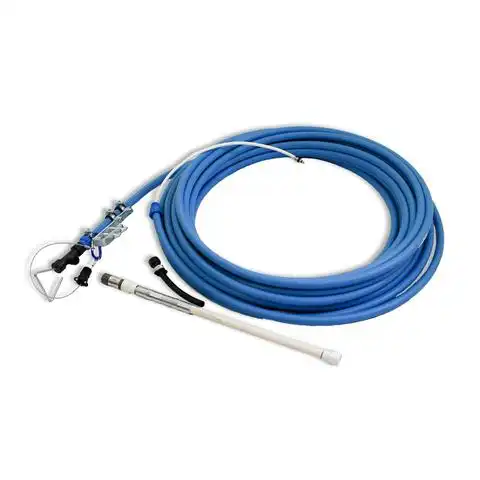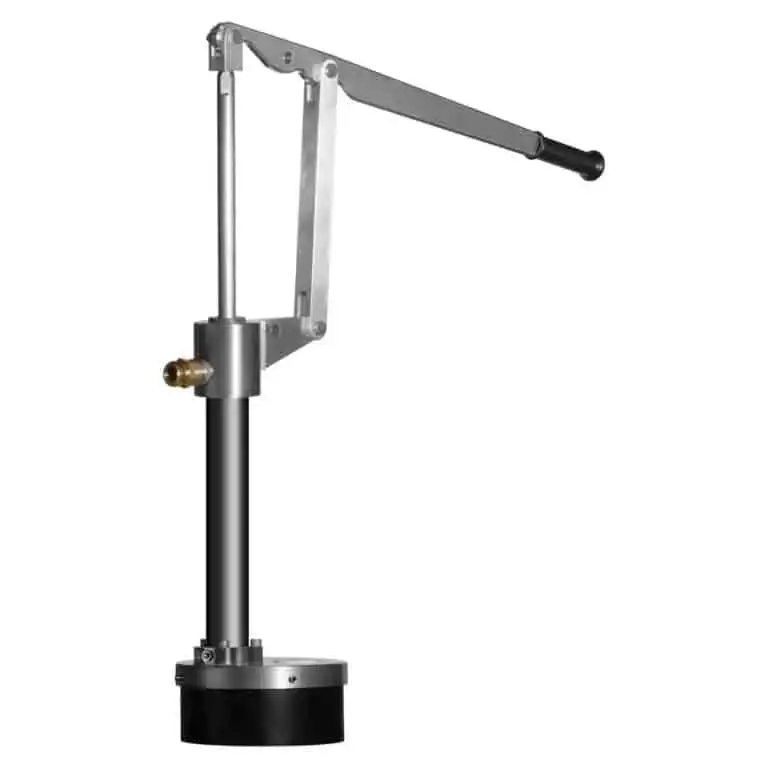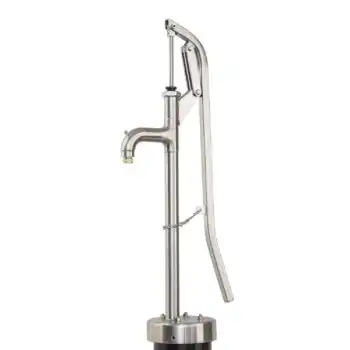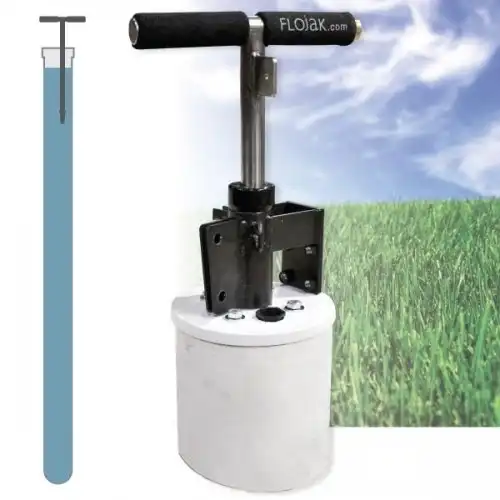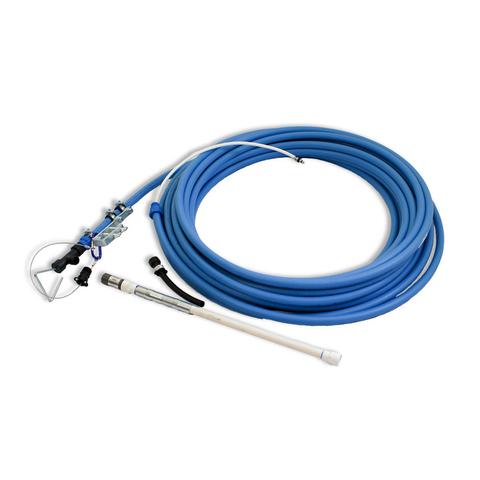
A Complete Guide To Buying & Installing A Manual Water Well Pump
Because access to your well water without the grid is vital to survival.
It means using your muscles to quench your thirst.
That way, you’ll NEVER have to worry about dehydration again…
That’s called “Peace Of Mind” – and worth every penny!
TOPICS IN THIS GUIDE… ↓(click to jump)
- Best Well Hand Pump Kits
- What Are They & How They Work?
- Hand Well Pump Features
- 4 Types Of Manual Well Pumps
- Sizing An Emergency Well Pump
- How To Install One Yourself
- DIY Deep Well Hand Pumps

Want a free 78 item prepper checklist?
Click here to instantly download this Complete Checklist PDF. No purchase necessary.Best Hand Pumps For Well Water
Sure, YOU could scour the internet,,,
Trying to find and compare the best backup pump options for you.
But here at Skilled Survival, we’ve done ALL that heavy lifting.
So here are our recommendations for the best hand pumps on the market today:
If you want a simple off-grid deep well hand pump you can't go wrong with this one from Legacy.
You can only store so much water ahead of a future emergency. So it's essential you have a lightweight manual pump you can pull out in an emergency.
Take it out of the box and you're ready to go.
There's no assembly with Legacy's emergency hand well pump. Because once you open it up it goes right into your well.
Adjust the pipe length and you are good to go.
It's also easy to pump so your kids can get in on the action.
With a simple setup and great portability, this pump is exactly what you need in an emergency.
PROS
- Excellent portability / Lightweight
- No Assembly (just adjust pipe length)
- Affordable (vs other options)
CONS
- The materials used are not as durable as metal
- Not designed as a permanent installation
↓ Gunslinger: Emergency Well Water Hand Pump
↓ Emergency Well Pump Demo
If you have a deep well you want to access manually, Simple Pump is here for you.
They reach almost all deep wells up to 325 feet and can fit right next to your submersible pump.
It's made to fit many handle sizes.
Also, you can convert it from a hand pump to a motorized pump with a solar-powered Simple Pump motor.
There are only a few parts so maintenance is simple and it works well in freezing conditions.
They use aerospace-grade stainless steel. Steel that's computer machined for exacting precision. So it's well made and long-lasting.
You can even pump directly into your pressure tank to get water inside your house.
You have 24/7 access to your well water regardless of whether the power grid is operating.
Simple Pump is a high-quality off-grid deep well hand pump that won’t let you down.
PROS
- Very high-quality materials used
- The precision design and parts
- Made to be installed and used anytime to save on power or emergency
CONS
- Very Expensive
↓ The Simple Pump Will Blow Your Mind
Bison is another manufacturer of great well hand pumps and they are best sellers in the category.
A Bison Pump is made from 304 stainless steel on the body, handle, lift rod, and accompanying hardware.
All component welds are professional and have a durable hand-polished finish.
With stainless, there is no chance of rust. So your drinking water is safe and secure, without contamination.
You don’t have to prime the pump and there is little maintenance.
It's also an all-weather pump. One you can use all year round without worrying about freezing. And there’s a tamper-proof security option you can add on as well.
Once you take 4-5 strokes you will get a water flow of about 20 ounces per stroke.
Bison offers a lifetime warranty on this deep-well hand pump. And they stand behind their products because they're THAT good.
PROS
- The all-weather pump can handle winter temps
- Low maintenance system
- Can upgrade to a tamper-proof security option
CONS
- Probably very expensive (have to call to get a quote)
↓ Demo: Bison Deep Well Hand Pump In Winter
FloJak Plus is another great well hand pump system you can get up and running for any off-grid well.
It comes in a 50, 100, and 150-foot options, depending on your well depth. And it's a narrow design that fits into an existing well beside an electric pump.
Determine the depth of the static water level so you can adjust the length of the PVC pipe.
Make sure to connect the pipes with primer and PVC cement for a tight, sealed bond.
Feeding it down the well may take a few people. Because you must position the rigid pipe slowly down beyond the water level.
Most of the upper, above-ground components are made of sanitary-grade stainless steel. Thus, are very rugged to last a lifetime.
The pumping action pushes water up the rod and out the handle. This design gives a smooth flow of pressurized water that can feed into your house’s plumbing system.
Thus allowing you to flush toilets, shower, and run water in the sink.
PROS
- Narrow design work alongside an existing electric pump
- Uses sanitary grade stainless steel (lasts a lifetime)
CONS
- More susceptible to freezing cold temps
↓ FloJak Instructional Video
For wells that have static water from 40-200 feet, the Apocalypse AR and SJ models can do the pumping for you.
They're designed with a pump and cable. This delivers water from your well with the upstroke pulling the cable. And moving water up while weights and gravity produce the downstroke.
The AR model pumps up to 3.5 GPM, while the SJ model pumps 1.5 GPM. The difference in models is the size of the piston and the length of the stainless steel cable.
This cable design is more cost-effective than pump rods. So they can lift water effectively from deeper wells.
They also use Teflon seals, and unlike rubber seals that may last up to 10 years, Teflon is indefinite. They claim they may even outlast the well.
All components are rustproof with PVC, Teflon, and stainless steel. And the installation is quick, clocking in at around 2 hours.
PROS
- Uses Teflon Seals to prevent rusting, corrosion, or freezing
- Maintenance-free and reliable
- 100% Satisfaction Guarantee
CONS
- Assembly Is More Complex Than Other Options
- Price Is Higher Than Other Options
↓ AR Demo Lift
What Is A Hand Pump & How They Work
An emergency hand pump is a device to manually hand pump from a well.
It’s a lever attached to a rod that pivots and plunges water.
When you raise the lever, a piston drops, creating suction.
And when you lower the level, a washer cuts off the flow of water, and it builds up in the pump.
As you continue, the water level increases until it flows out of the valve.
↓ How Hand Pumps Work (hydraulic water pump)!
Who needs such an emergency backup pump?
- Off-grid cabins
- Bug out locations
- Homesteads
- Remote Farms
- Backup to an electric pump
We’ve all experienced times when the power goes out, right?
Left in the dark.
YES, it sucks but usually it’s only short-term.
But what if it wasn’t?
What if it’s a large-scale catastrophe to the energy grid?
A Nuclear Attack or an EMP?
Well, THAT’s why you need a surefire way to get water out of your well.

Want a free 78 item prepper checklist?
Click here to instantly download this Complete Checklist PDF. No purchase necessary.Best Hand Well Pump Features & Benefits
Now, you’re here because you want to learn how to thrive in an emergency.
To become resilient to a worst-case scenario.
And that means figuring out your survival plans, including:
- Bug-out location
- Food
- Medical supplies
- Survival gear
- Backup power
- And most important, water
Water is the elixir of life.
Without it, you’re done.
And water wells are a great, independent source of H2O, right?
But most still rely on the power grid to operate.
- But what if the grid goes down and there’s no electricity?
- Or is the sun behind clouds, and your solar water pump is dead?
You need a backup plan to get your water to the surface.
Beyond the obvious reasons, there are other benefits to investing in a backup well pump.
Cheap and Durable
These pumps don’t rely on electricity.
Instead, it gets its power from YOU.
You don’t pay for power when you use it; you use your muscles.
They also have few moving parts, so maintenance is minimal.
Versatile and Efficient
An emergency well pump works in many applications, including:
- gardening
- construction
- and homesteading
You can operate them at different heights, from deep wells to shallow ones.
They even work in water drums.
And the only limits to capacity are your own strength and persistence.
Plus, they’re quiet and safe for all family members to use.
Easy Installation
With demand comes innovation.
The best pump kits are easy to install and get up and running fast.
First, determine the total depth of your existing well.
That way, you know the amount of pipe to extend your pump below the waterline.
The model you want is compact and simple to setup.

Want a free 78 item prepper checklist?
Click here to instantly download this Complete Checklist PDF. No purchase necessary.4 Types Of Manual Well Pumps
Gone are the days of digging a well and using a bucket and rope.
There are several types of water well hand pumps to choose from:
1. Suction
These are for rural farms or homesteads.
Locations where you need unfettered water from a well where no power is available.
They are low-cost pumps for shallow wells with a lift capacity of around 20 feet.
IT needs to work at a steady pace to get (and keep) the water flowing.
2. Piston
This type of hand pump for well in emergency works for deeper water levels.
These wells are over 25 feet deep.
And use a piston to displace the water upward.
You draw water up and trap it above a check valve.
3. Deep Well
This is the best solution when lifting water beyond 35 feet.
They use a mechanical system like a flywheel.
And are more heavy-duty and stronger.
There’s virtually no limit to the depth they can operate.
The only limit is the elbow grease of the person operating it.
4. Lift
This option gives access to water over 150 feet deep.
These depths are often necessary in poor or developing areas of the world.
It includes cylinders to scoop the water and brings it upward with a chain looping.
It’s an old hand-pumping technology but works great without much effort.
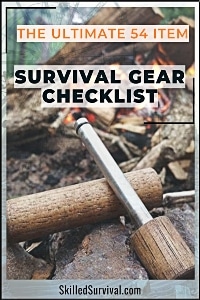
Want a free 54 item survival gear checklist?
Click here to instantly download this Complete Checklist PDF. No purchase necessary.How To Size An Emergency Well Pump
Before shopping, figure out the proper size.
What’s your static water level?
This is the distance from the top of the well (at ground level) down to the top of the water level.
Where the water level starts, you’ll usually find saturated crushed rock.
And this is where your well is dug past to access the water.
Often your electric pump will sit at the bottom.
So you only need to reach around 10 feet below the water level to successfully operate.
Perform a depth test with a weighted line.
Use a weight and a bobber so it will reach the water.
Once the bobber floats on the water, take up the slack and mark the line.
Then you can pull it back up and measure the distance.
You now have your well depth.
The depth of the water level will determine the right type of pump for you.
↓ Well Pump Sizing

Want a free 78 item prepper checklist?
Click here to instantly download this Complete Checklist PDF. No purchase necessary.How To Install A Hand Well Pump
Installation of these devices can range from easy to complex.
Of course, follow ALL the instructions.
Will it have a flexible plastic hose or a semi-rigid PVC pipe?
Depends on the design.
You’ll feed it down your well.
Feed it in slowly, so you don’t damage any electrical wiring.
Usually, existing wells will have an electric pump sitting on the bottom.
The new one will be submerged around 10 feet past the static waterline.
With the piping in place, you can secure the pump mechanism at the top.
And then attach all remaining components.
Want a free 78 item prepper checklist?
Click here to instantly download this Complete Checklist PDF. No purchase necessary.DIY Deep Well Pump
If you don’t want to spend money; make your own.
You’ll need basic tools and equipment.
But if you are handy it’s fairly simple.
You can put together your own with PVC pipe.
Buy the right length for your deep well depth.
Start by constructing the foot valve assembly.
This will let water into the pipe cylinder without letting it back out.
Next, build the plunger mechanics to seal the cylinder and create suction.
It also has a second valve to force water into the upper pipe.
Build the head assembly and attach it to the piping.
This way, water flows out of a spout with a lever arm and handle.
Here’s a video on one way you can build:
↓ SIMPLE DIY Well Hand Pump
Why Trust Skilled Survival...
Go here now to review a full breakdown of:
- Who We Are
- Our Credentials
- Our Mission
- & Product Recommendations...
Here are a few highlights of our teams credentials & certifications:
- Certified Member of a Mountain Search & Rescue Organization
- Plant Emergency & Safety Leader for a Major Food Manufacturer
- Member of the 10TH Mountain Division Hut Association
- Certifications: Avalanche 1, WFR, CPR
- Official Gear Tester for Numerous Outdoor Gear Companies
- Countless Multiday Backpacking trips into Remote Wilderness
- Bachelor's Degree In Mechanical Engineering
- Bachelor's Degree In Civil Engineering
- Bachelor's Degree In Biomedical Engineering
"It takes 20 years to build a reputation and five minutes to ruin it." - Warren Buffett
We're fully aware that trust is NOT something you GET but is EARNED.
And we'll continue to earn YOUR trust through our forthright and honest approach with each new Blog Post, Guide & Product we create...
Prepare, Adapt & Overcome,

P.s. Do You Live In A 'Danger Zone' County?

Find out now using my Danger Zone County List & Special Report it’s absolutely FREE.
In minutes you’ll know EXACTLY where you stand and if you should be worried or not..
So click here to get my FREE Danger Zone County List & Report…

Recommended Reading
Best Emergency Canned Water Quickly Get Extra Prepared
Yes, you can buy emergency canned water to build your stockpile. But does it make financial sense? We answer this question plus more...
7 Best Solar Water Pumps: High Tech Off Grid Survival
Solar powered water pumps are quickly becoming the most popular way to move water. We'll show you the best kits on the market today.
Best Water Containers To Survive A Deadly Drought
Not all containers are created equal. We review the best water storage containers to keep your family safe and hydrated for the long haul.
